These soft & chewy gluten-free oatmeal cookies are so simple to make. The dough comes together with 12 ingredients in 1 bowl, and the cookies are ready to nom in about 30 minutes. Toasted oats build flavor in the dough, and a blend of sweet rice and oat flour gives them a classic oatmeal cookie texture with crispy edges and soft middles. Made with simple, minimal ingredients and no xanthan gum!
These cookies are equally delicious when studded with chunks of dark chocolate or kissed with cinnamon, nutmeg, and plump, sweet-tart raisins. Go wild!
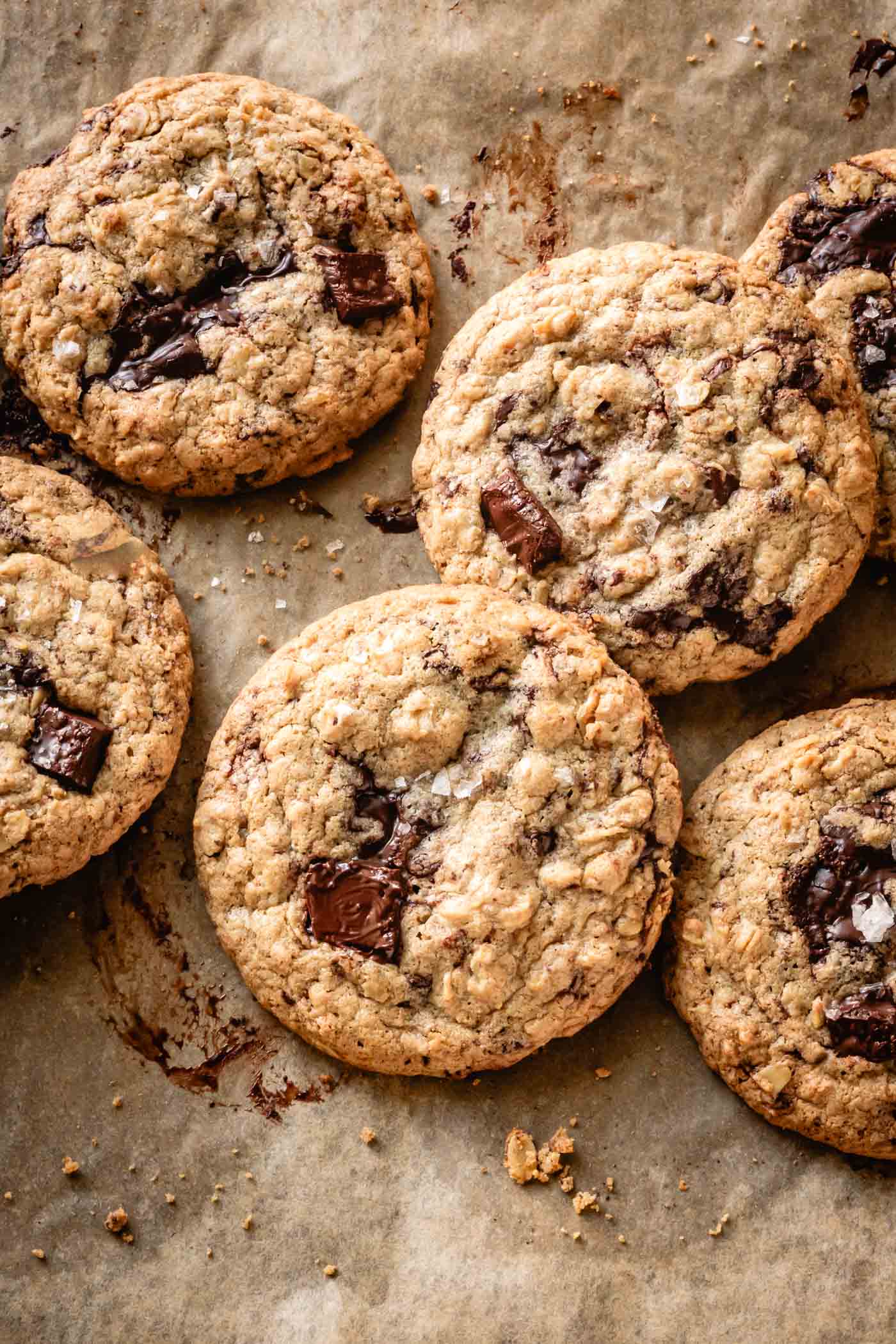
Of all cookie recipes, it should be obvious by now that I have a special place in my heart (and stomach) for oatmeal cookies. They feel so cozy with satisfying heft and classic, earthy flavors from brown sugar and oats. I recently shared a recipe for oatmeal cookies made with almond flour, and I also have a version using teff flour, nutmeg, and whiskey-soaked currants in my award-winning cookbook.
But these gluten-free oatmeal cookies are the ones to make when you want a classic cookie that tastes like the ones mom used to bake.
The cookie dough is versatile, so you can add chocolate chips or chunks (shown here), or stir in cinnamon, nutmeg, and plumped raisins. You can add toasted nuts if you like to either version.
The cinnamon raisin oatmeal cookies remind me of tea parties with my maternal grandmother, Anne, while the oatmeal chocolate chip cookies are the ones Jay and I crave on rainy days.
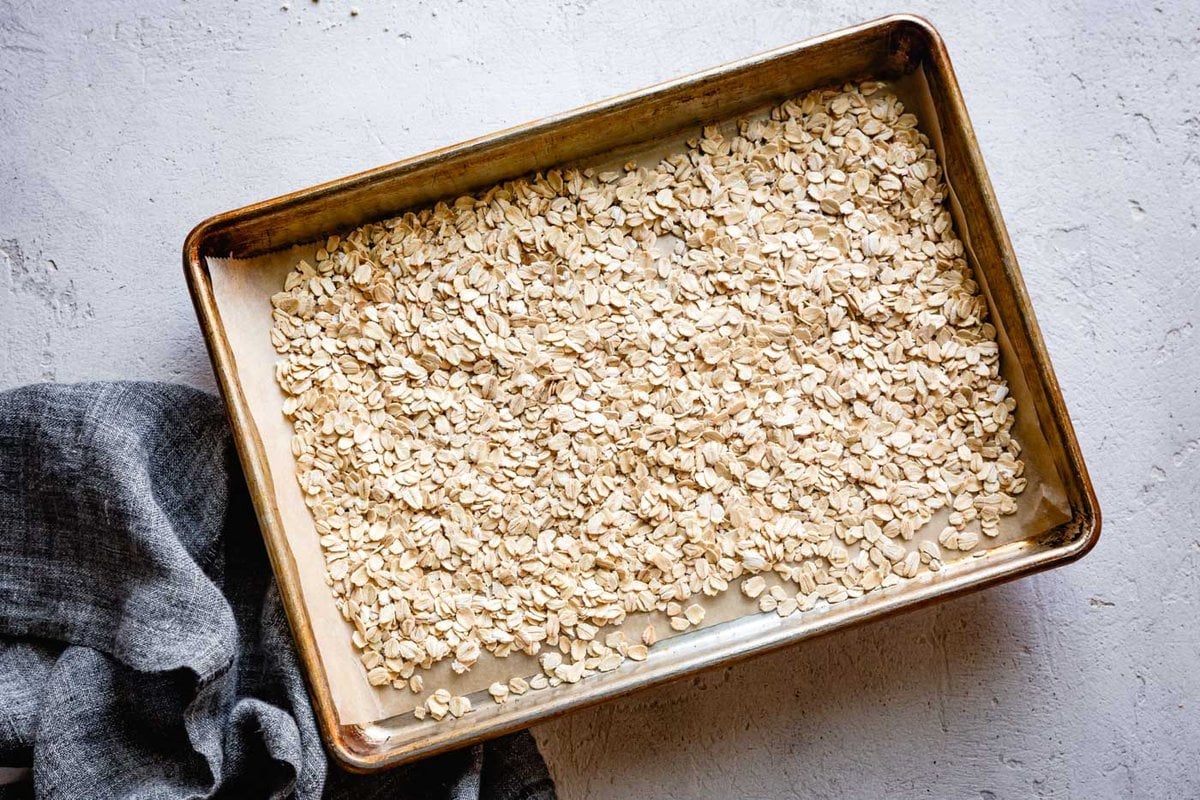
Toasted Oats + Oat Flour = Flavorful Cookies
While testing this recipe, I learned that oatmeal cookies can be pale, pasty, bland things that taste like a punishment version of chocolate chip cookies. That's because oats have a mild flavor that sucks up flavor.
The solution is a tip I picked up from Cook's Illustrated: toast the oats for 5 minutes until golden and fragrant before adding them to the cookie dough. This creates some caramelization on the oats themselves which builds a layer of flavor right from the start.
Additionally, a good hit of salt sharpens the flavor along with brown sugar (organic dark brown sugar has the most flavor). In the chocolate version, vanilla adds luscious floral notes and chocolate adds bittersweet depth. In the cinnamon raisin version, cinnamon, freshly-grated nutmeg, and raisins plumped in hot water or tea add cozy vibes that taste like a big hug.
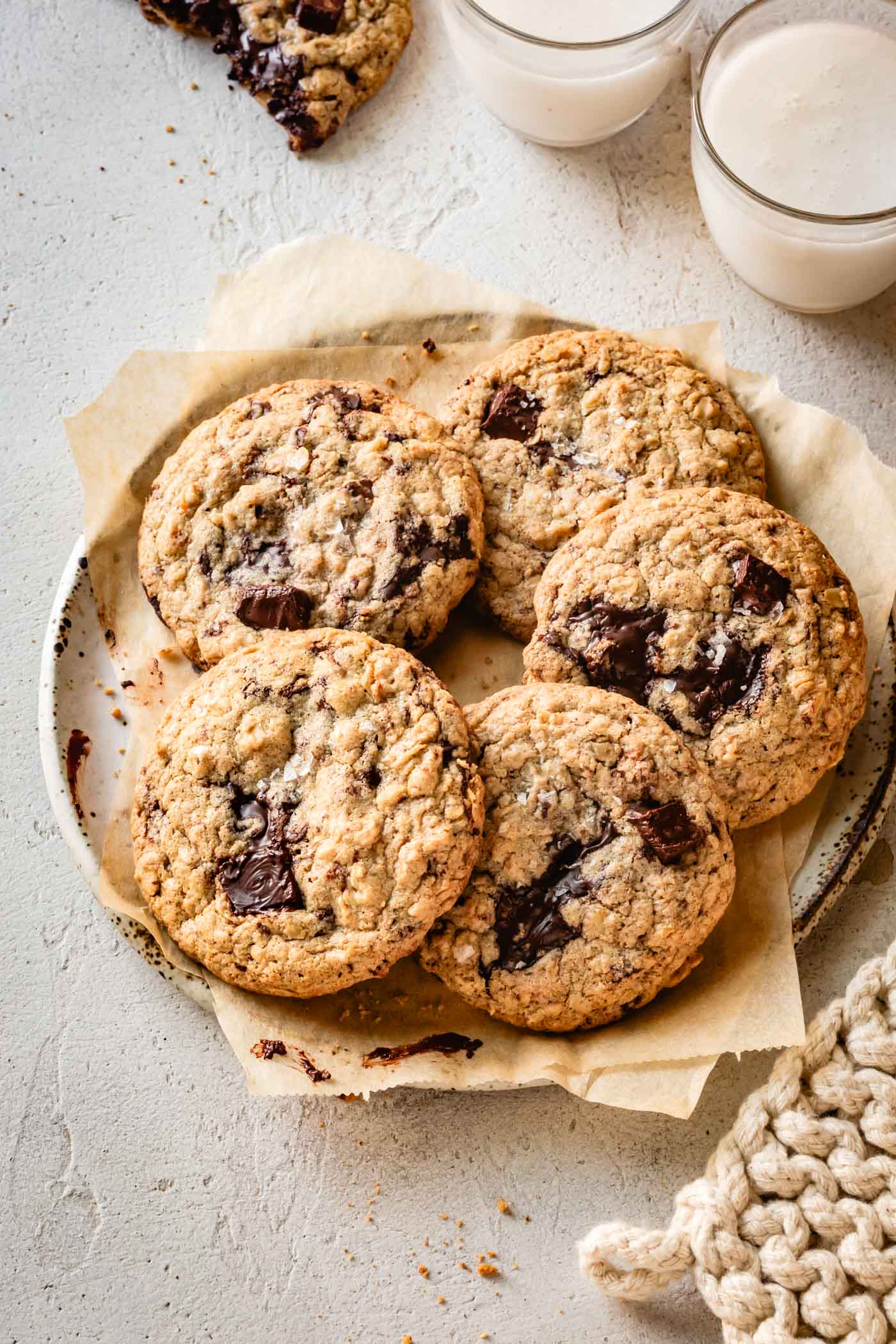
Texture is Everything
The texture of these GF oatmeal cookies is spot on thanks to a blend of gluten-free flours (sweet rice, oat, and tapioca). They bake up with crispy, golden edges and chewy, gooey middles. They're pretty spectacular warm from the oven, but they also keep like a dream for several days, staying moist and tender.
These cookies are:
- soft, moist & tender
- hefty & chewy
- full of flavor
- undetectably gluten-free with classic cookie vibes
- simple to make in about 30 minutes with 12 ingredients
I hope these gluten-free oatmeal cookies satisfy your craving!
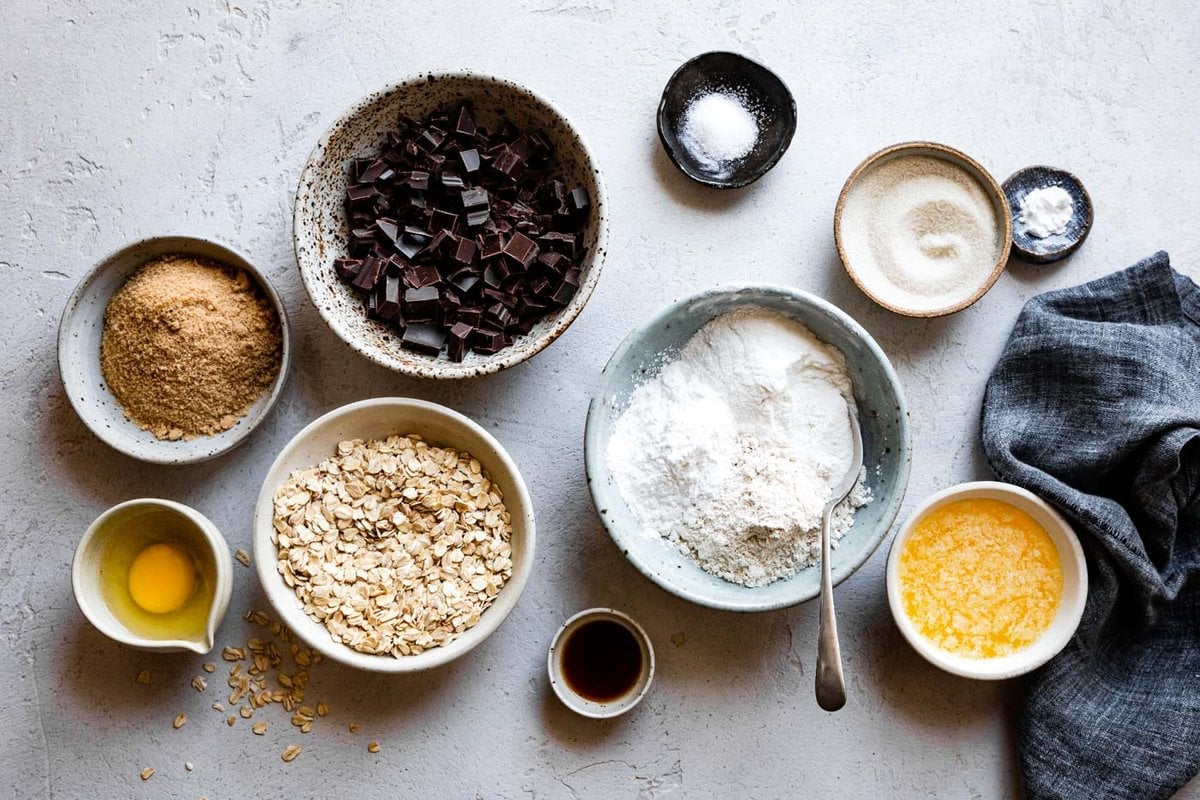
Ingredients & Substitution Suggestions
This recipe uses just 12 simple ingredients.
Flour Power
All gluten-free flours have their own unique properties, and I like to harness the power of each flour to underline each recipe. Instead of using an all-purpose flour blend, which is what many gluten-free oatmeal cookie recipes call for, I use a unique mix to create the best flavor and texture.
Here are the flours that I use to make really good gluten-free oatmeal cookies, what each flour does, and how to substitute them. You can click the links below to find more recipes using each flour. And you can nerd out on these and more in my guide to gluten-free flours for baking.
- Oat flour adds substance and rich, earthy flavor.
- Sub by weight sorghum flour, teff flour, millet flour, or light buckwheat flour. Or make these almond flour oatmeal cookies instead.
- Sweet rice flour makes the cookies chewy thanks to its sticky texture.
- Sub by weight gluten-free all-purpose flour such as Bob's Red Mill 1 to 1 flour.
- Tapioca flour helps the cookies hold together, making them soft and chewy.
- Sub by weight arrowroot flour or cornstarch.
Other Ingredients
More goodies for your cookies.
- Salt sharpens the flavors.
- Baking soda helps the cookies spread and brown.
- A combination of brown sugar and granulated sugar sweeten the cookies, adding rich molasses notes.
- Sub by weight coconut sugar for both sugars for refined sugar-free.
- Old fashioned rolled oats add texture and heft. Be sure to use gluten-free oats if need be.
- Butter moistens the dough.
- Sub dairy-free butter such as Miyoko's, decreasing the salt if necessary.
- Egg gives the cookies just the right amount of spread, adding protein to hold the dough together.
- For egg-free cookies, try these vegan tahini oatmeal cookies or vegan almond butter cookies instead.
For Oatmeal Chocolate Chip Cookies (shown here)
- Chopped bittersweet chocolate melts into gooey pockets.
- Sub chocolate chips if you prefer. For refined sugar-free, use chocolate sweetened with maple or coconut sugar such as Hu, Raaka maple, or Rad chocolate.
- Vanilla extract adds floral notes.
For Oatmeal Raisin Cookies
- Raisins plumped in boiling water (or tea) add chewy, sweet-tart flavor.
- Try dried cranberries for a festive variation.
- Cinnamon and nutmeg (freshly-grated nutmeg has the loveliest flavor!) add cozy spice.
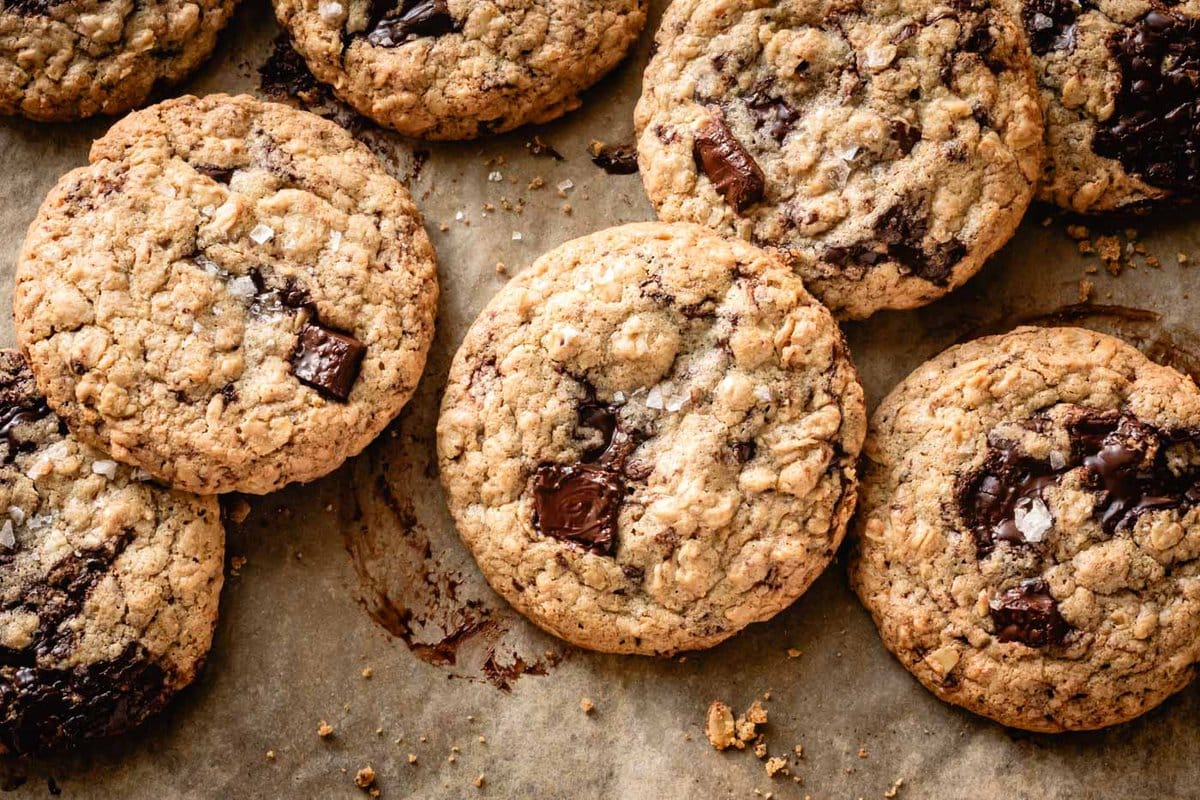
How to Make Gluten-Free Oatmeal Cookies
This recipe takes about 30 minutes to make, start to finish. It makes a small batch of cookies, about 15 medium-sized cookies, so feel free to increase the recipe as needed.

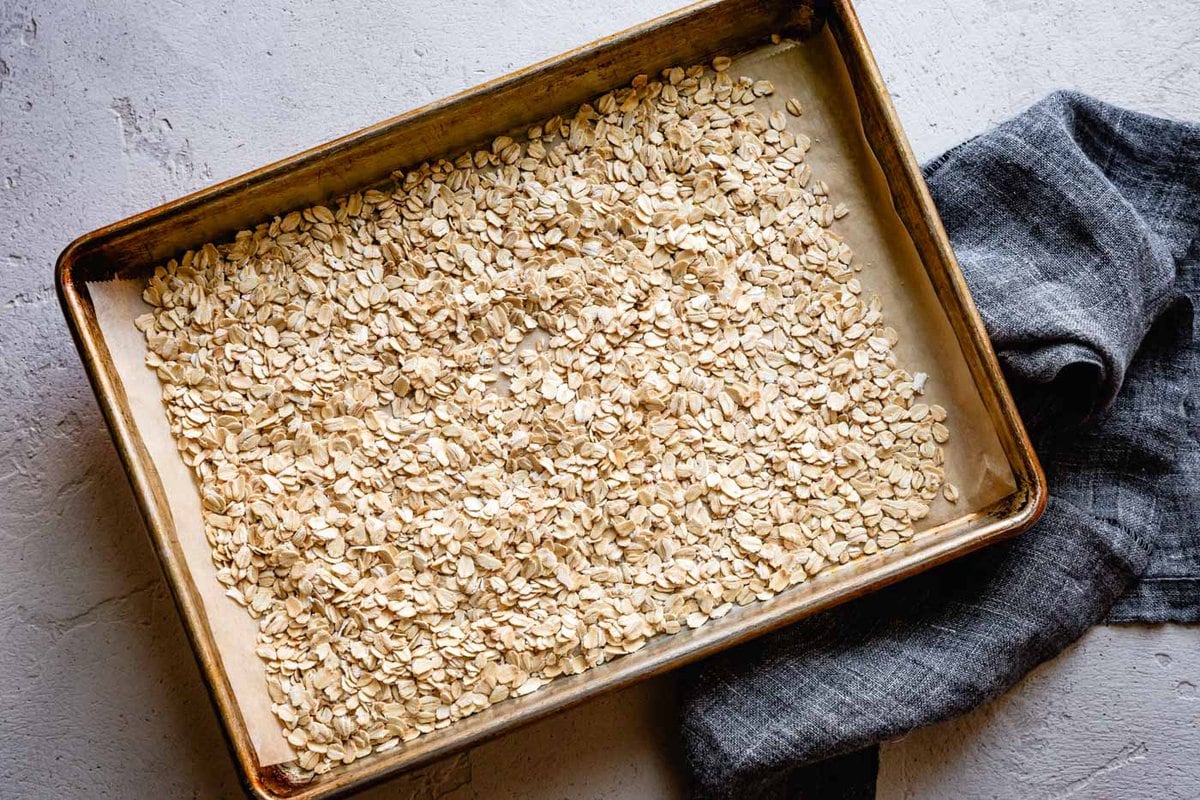
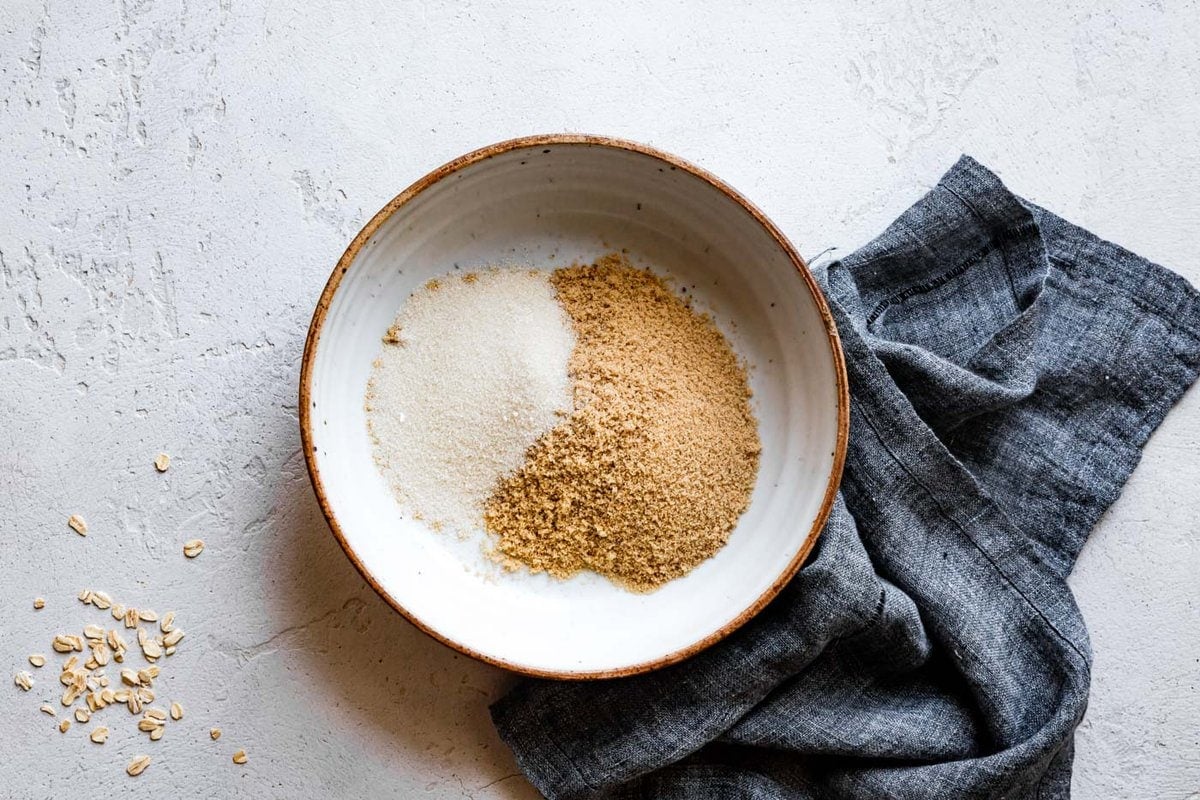
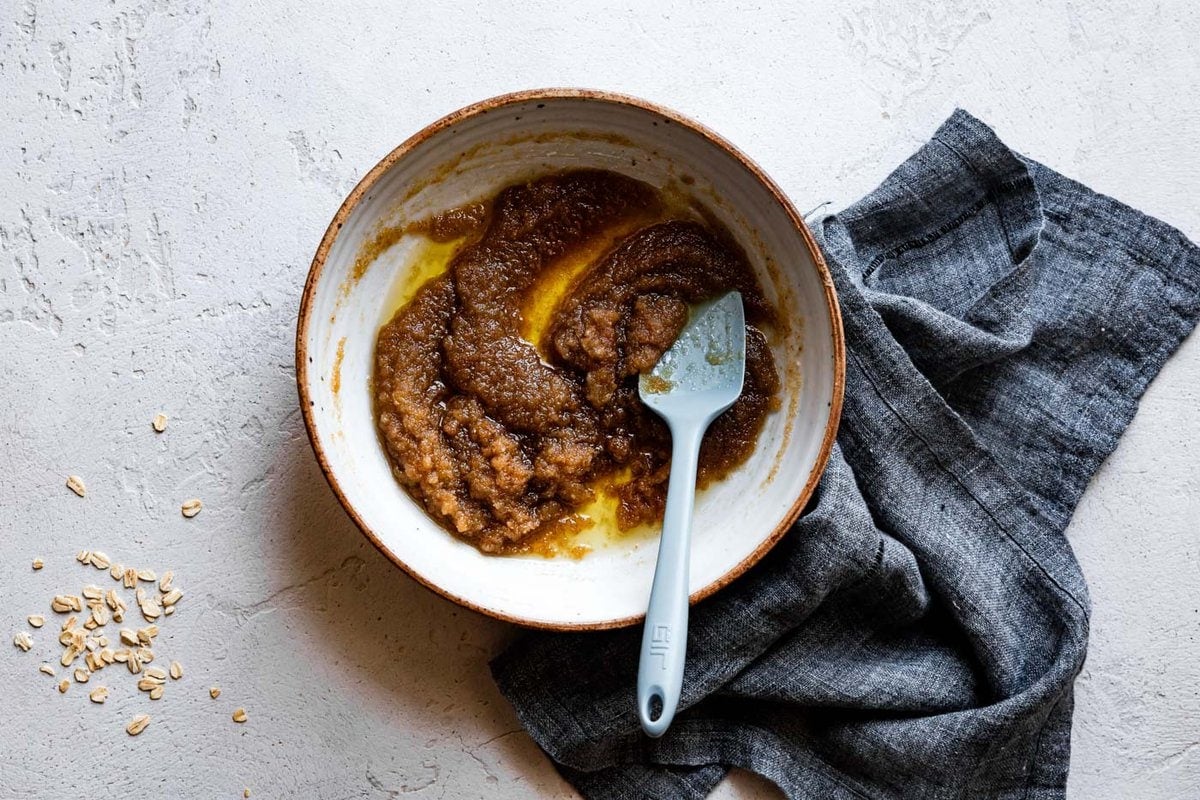
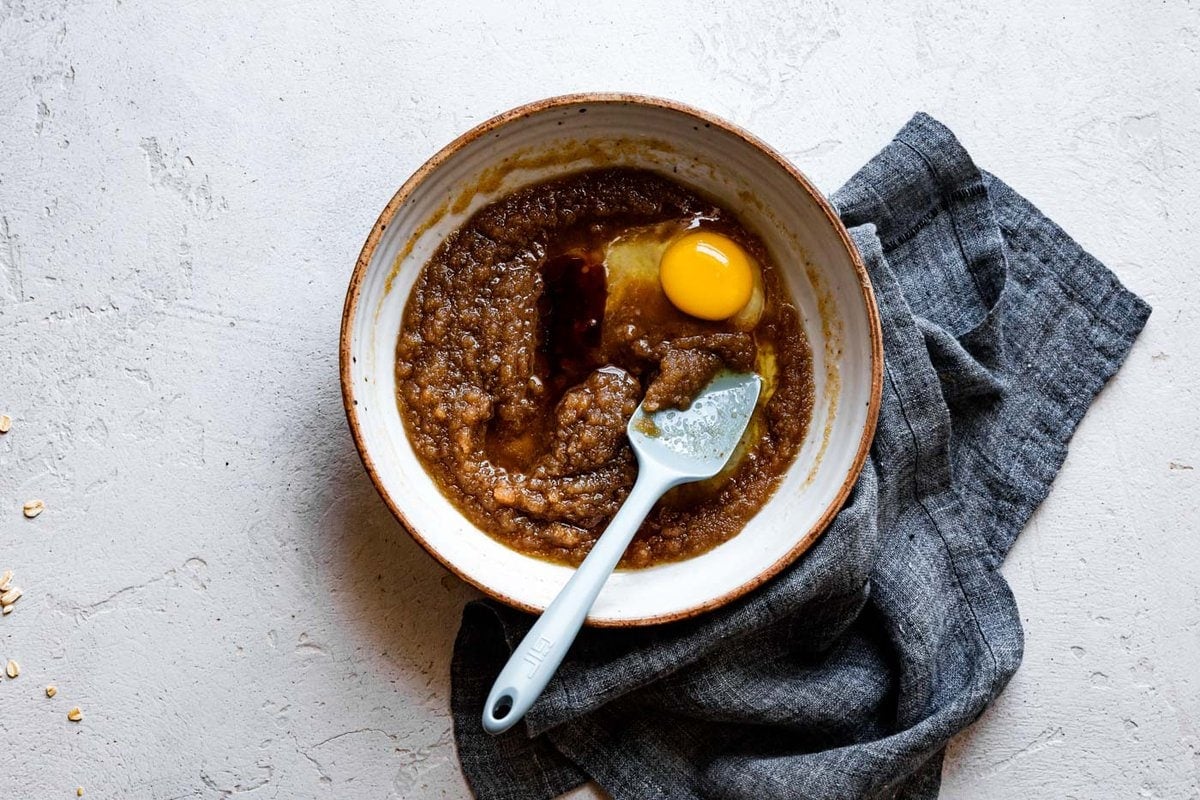
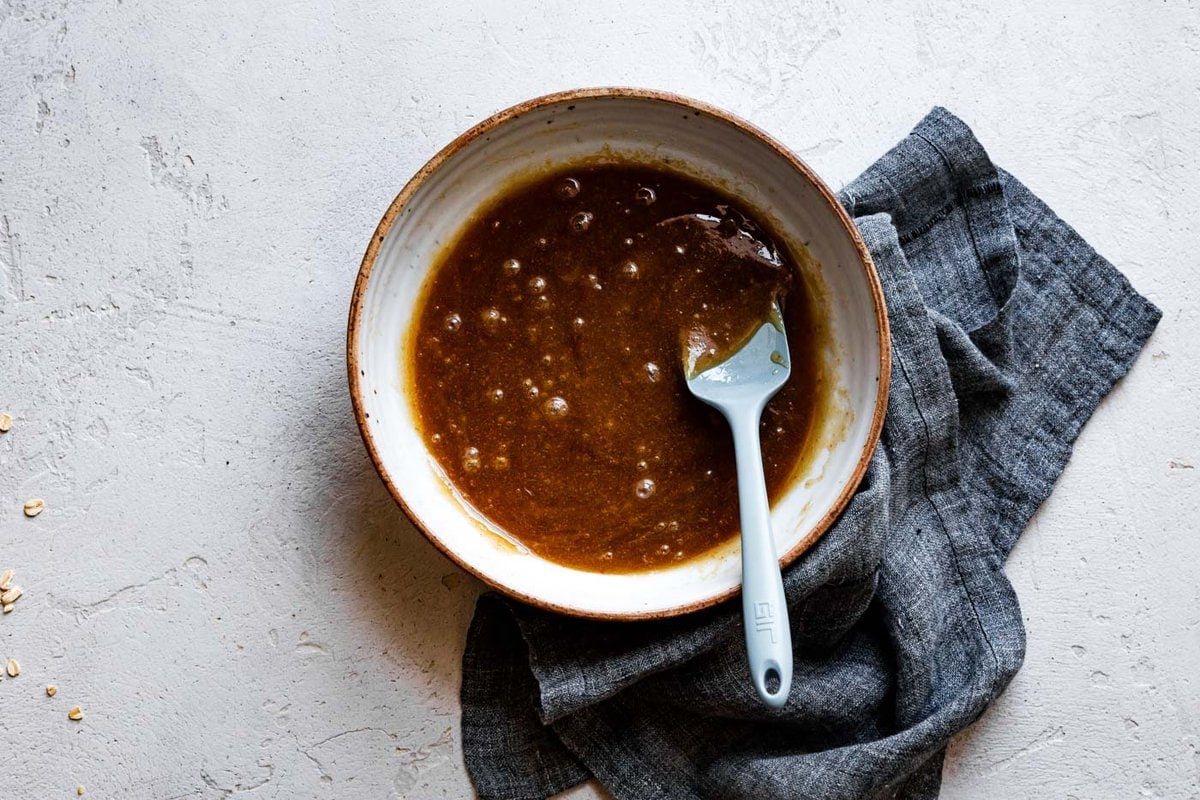
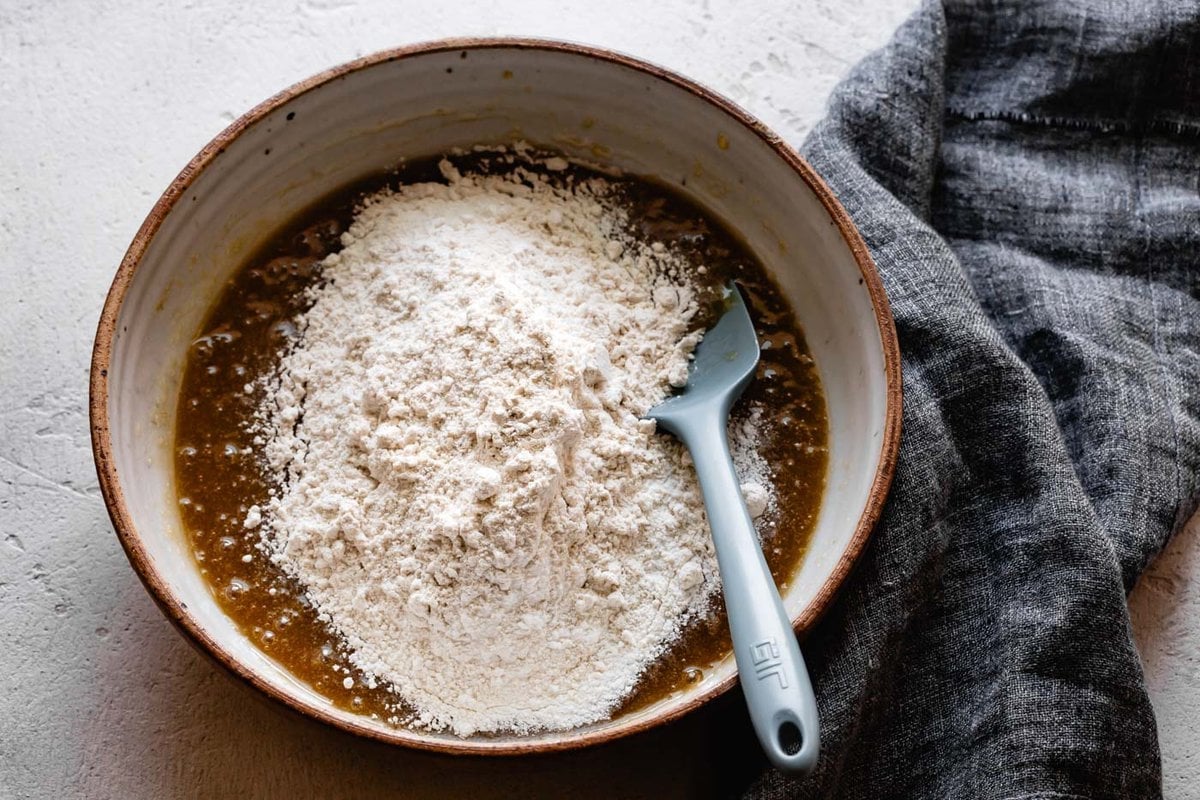
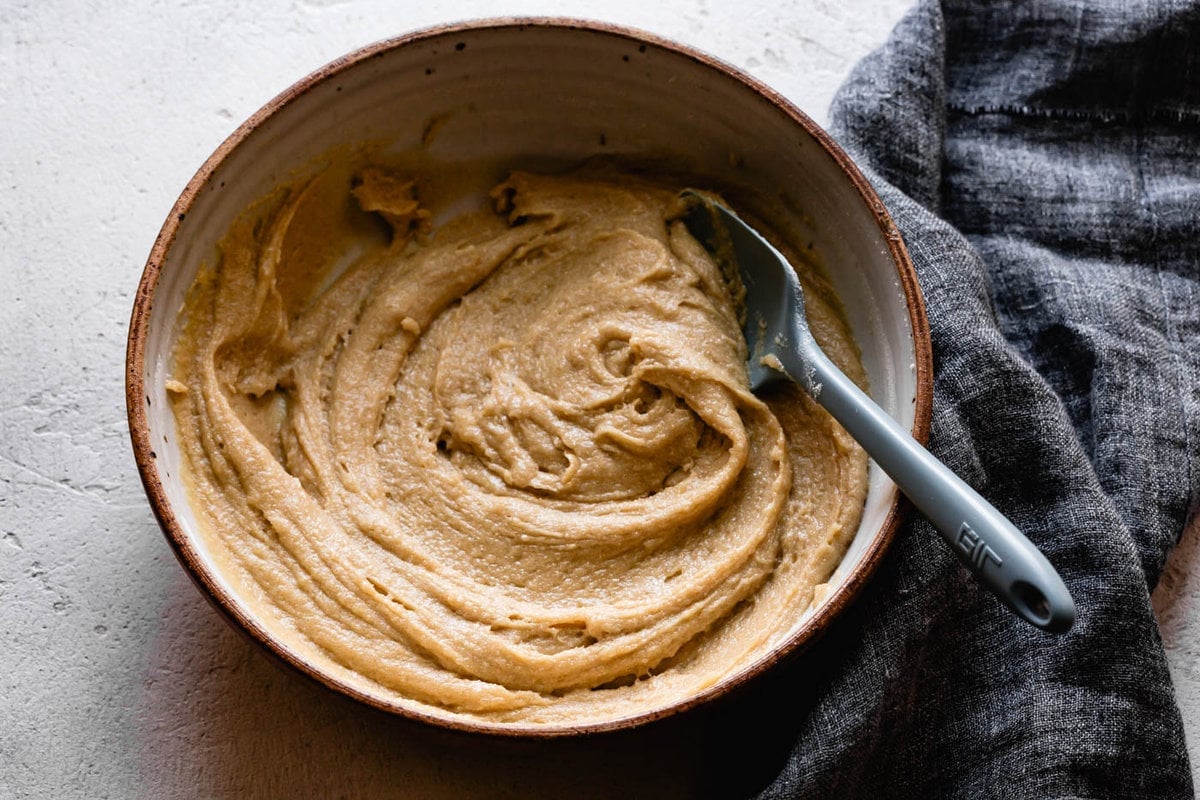
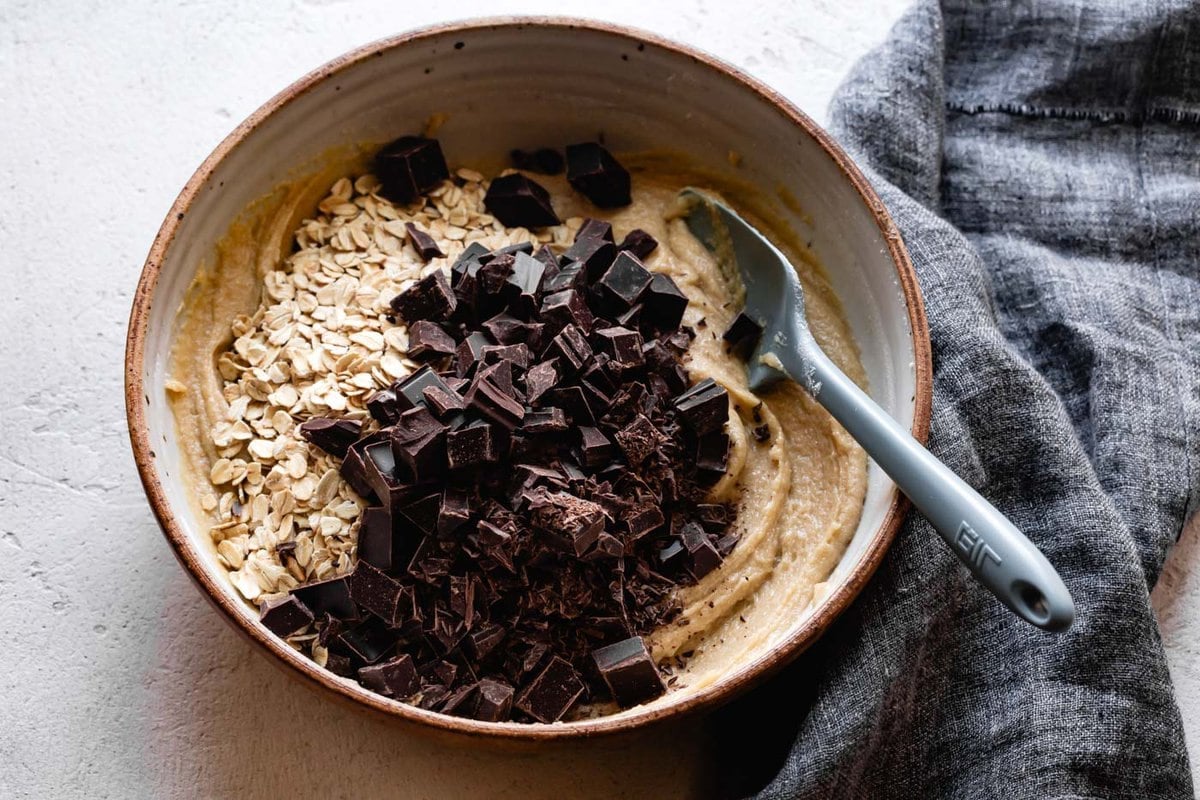
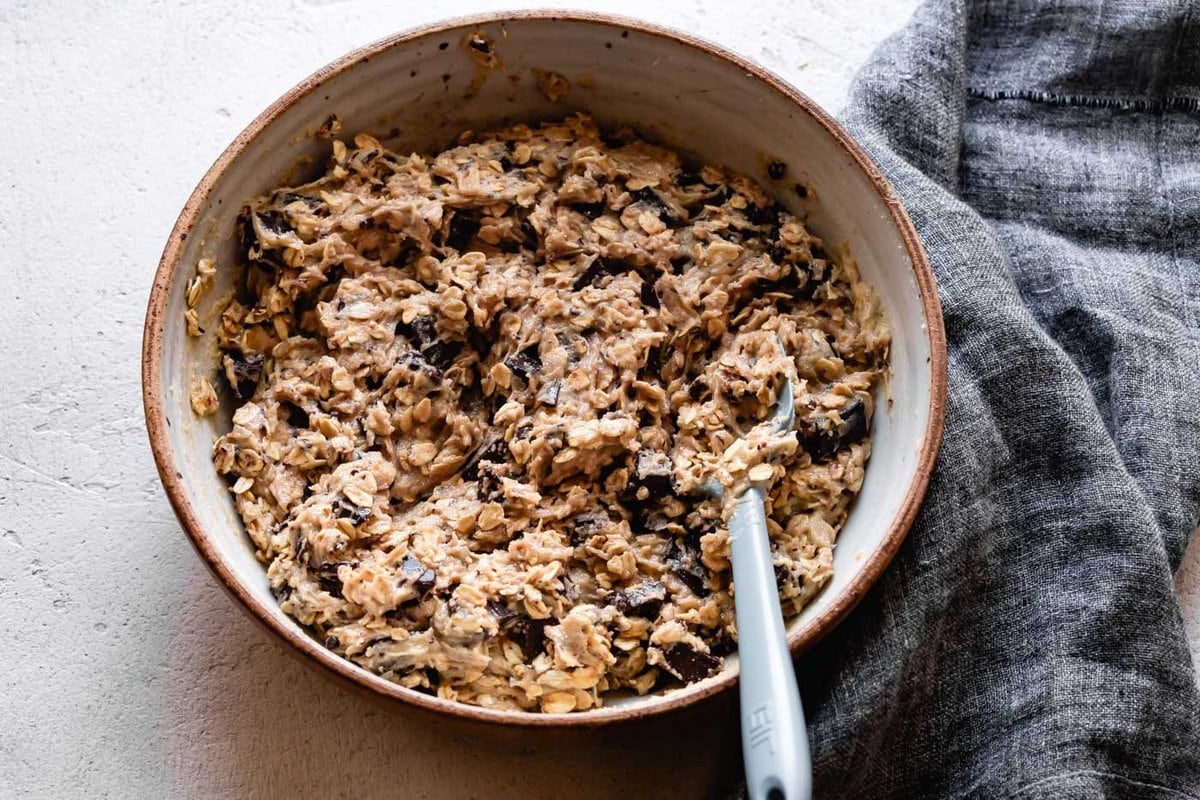
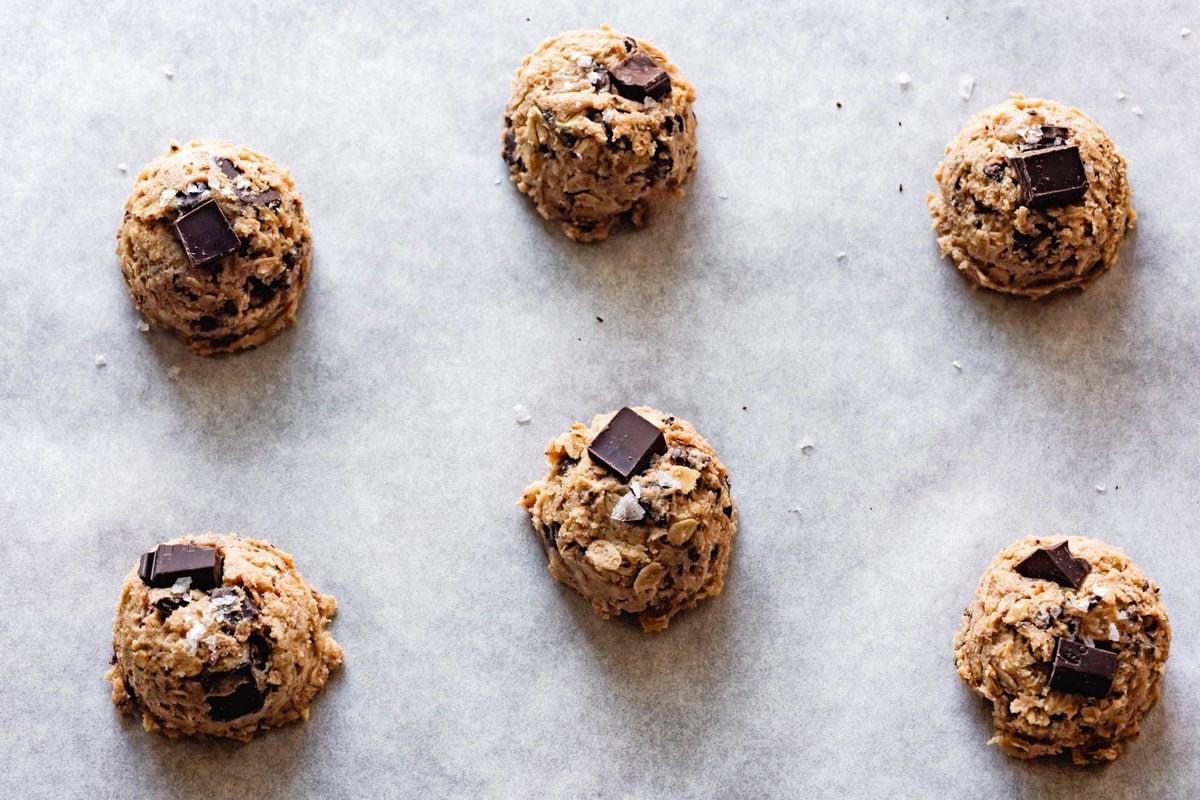
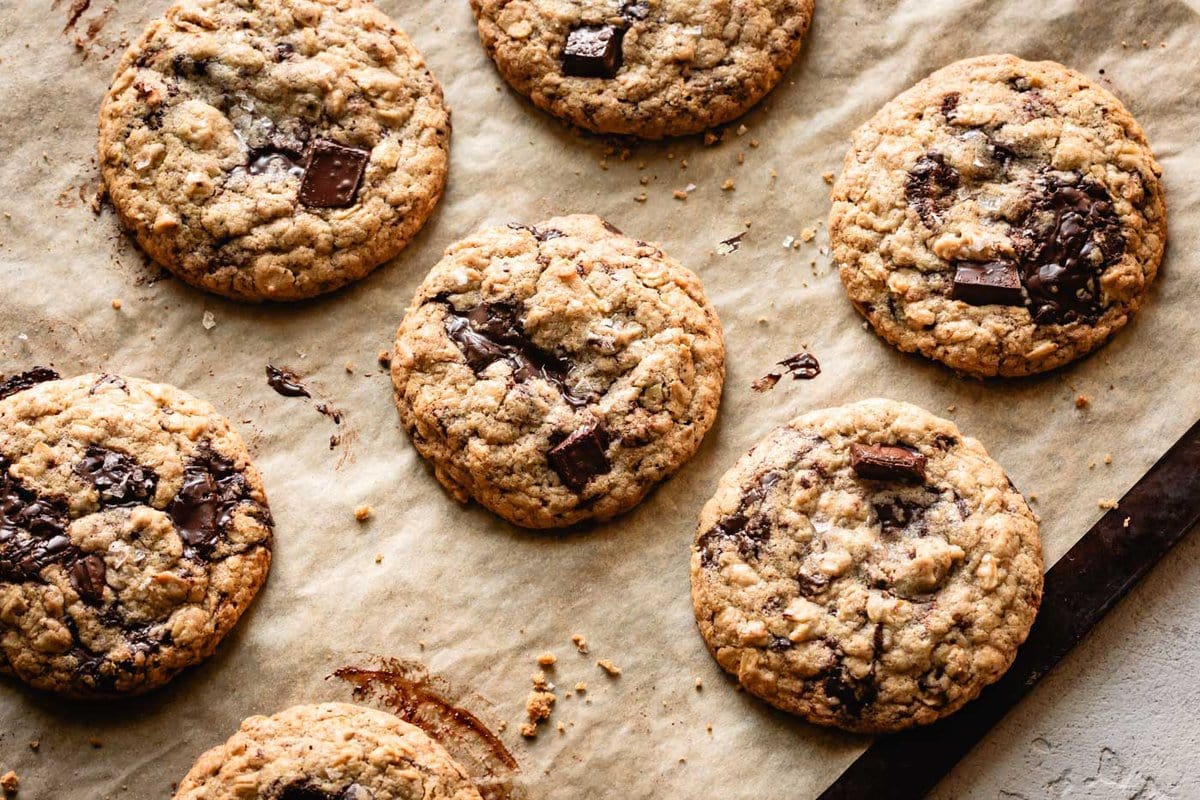
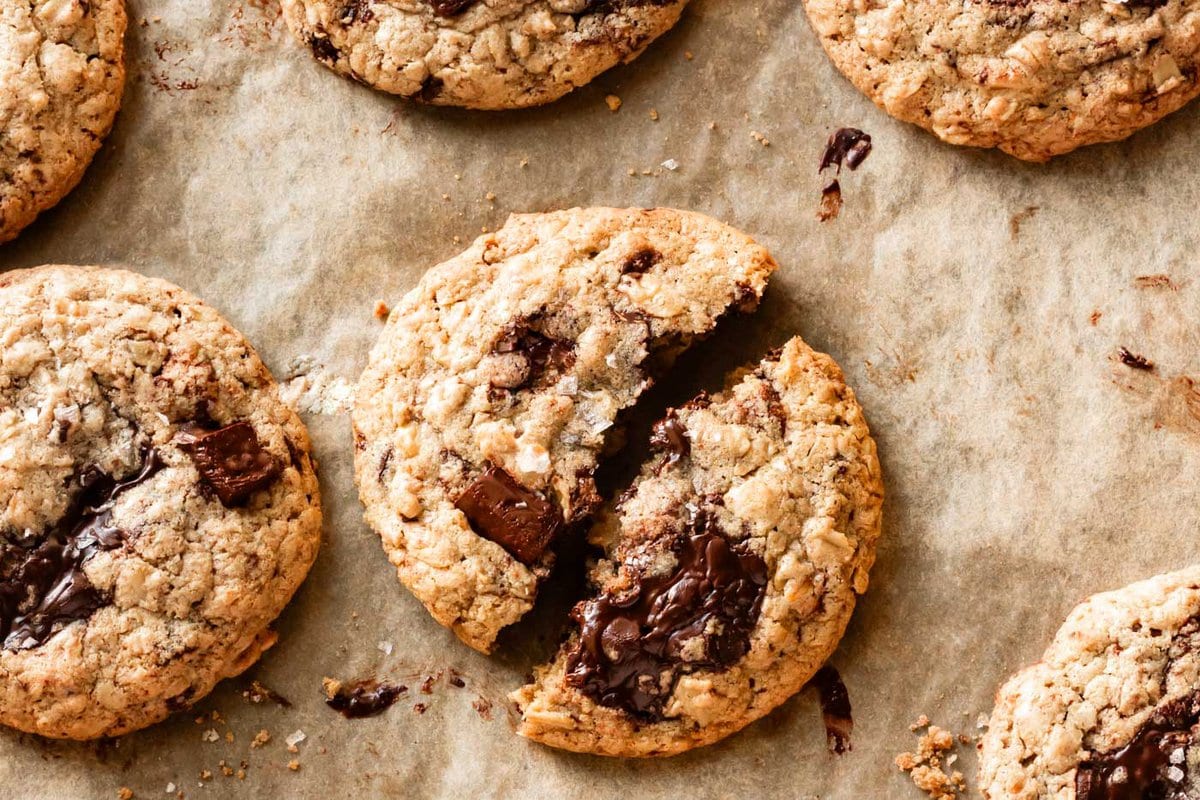
Make-Ahead Options
These gluten-free oatmeal cookies can be made ahead for fresh, gooey cookies whenever the whim strikes. Here's how to do it:
- Make the dough as directed, then let sit until firm enough to scoop (or chill for a few minutes to speed this up).
- Scoop the dough into balls using a cookie scoop, place the dough balls on a small baking sheet lined with parchment, and chill until firm, about 1 hour.
- Transfer the cold dough balls into a container and chill for up to a week. Or freeze for up to several months.
- To bake, place dough balls on a cookie sheet as directed. Let them soften slightly before baking for the best spread.
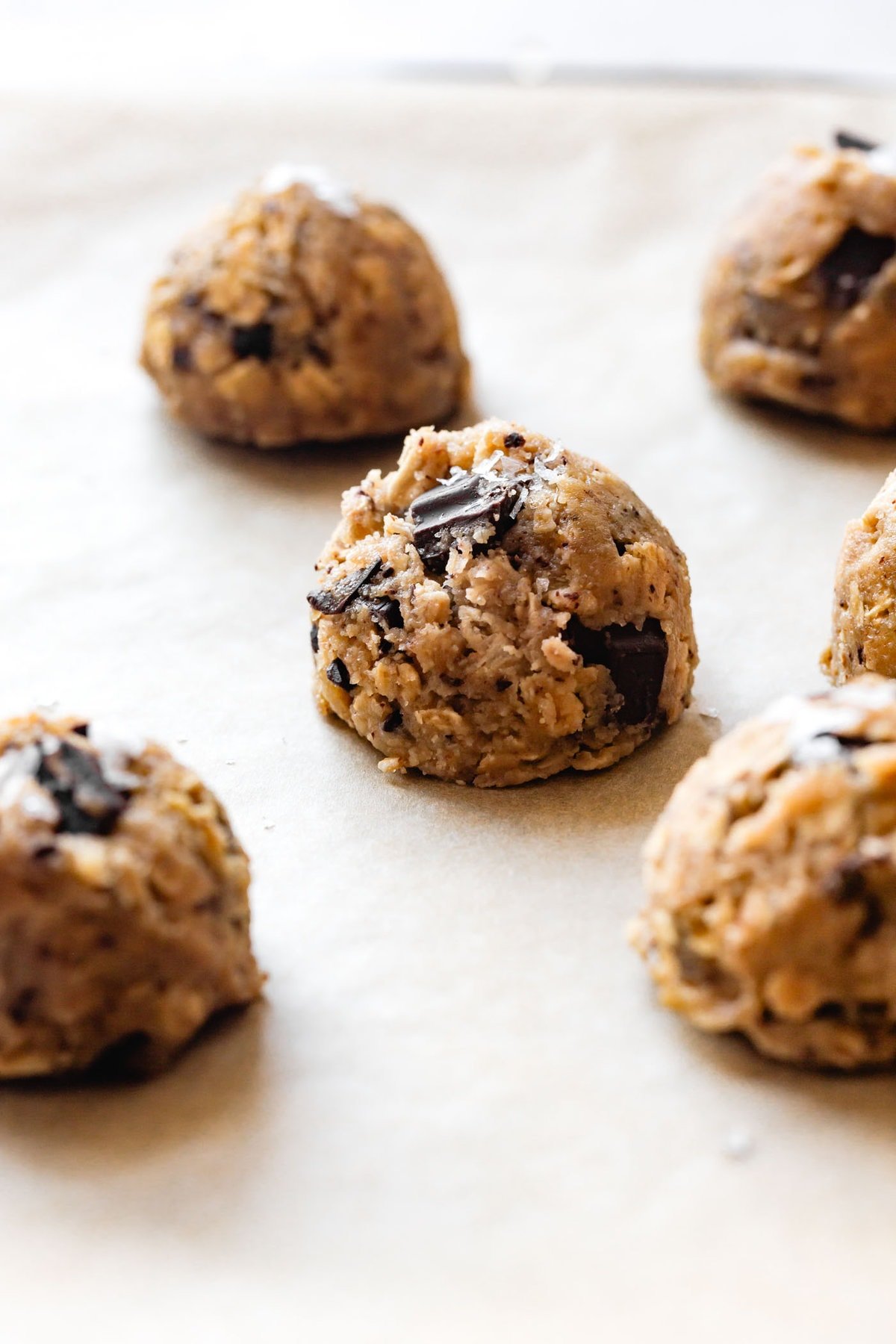
Tips for Baking Better Cookies
Cookies are at once one of the simplest treats to bake and one of the most sensitive. Here are a few tips to ensure oat flour oatmeal cookie bliss.
- Make sure your oven temperature is accurate. I recommend using an external oven thermometer.
- Make sure to measure accurately. For best results, weigh your ingredients with a food scale. This is the one I use.
- When measuring by volume, use the dip and sweep method for flours: fluff up your flour, dip in your dry measuring cup, and use a flat butter knife or small offset spatula to sweep away the excess so that the flour is level with the cup. For brown sugar, pack it well into the cup; it should mostly hold the shape of the cup when turned out into the mixing bowl.
- Bake off a single test cookie before baking the full batch. This way you can adjust the rest of the dough or the oven temperature before baking off the full batch. (This is a tip I learned from my pastry chef days!)
- Pull the cookies from the oven when they look underbaked. The edges should be just starting to color, while the tops should be puffed and soft, collapsing when you touch them gently with a fingertip.
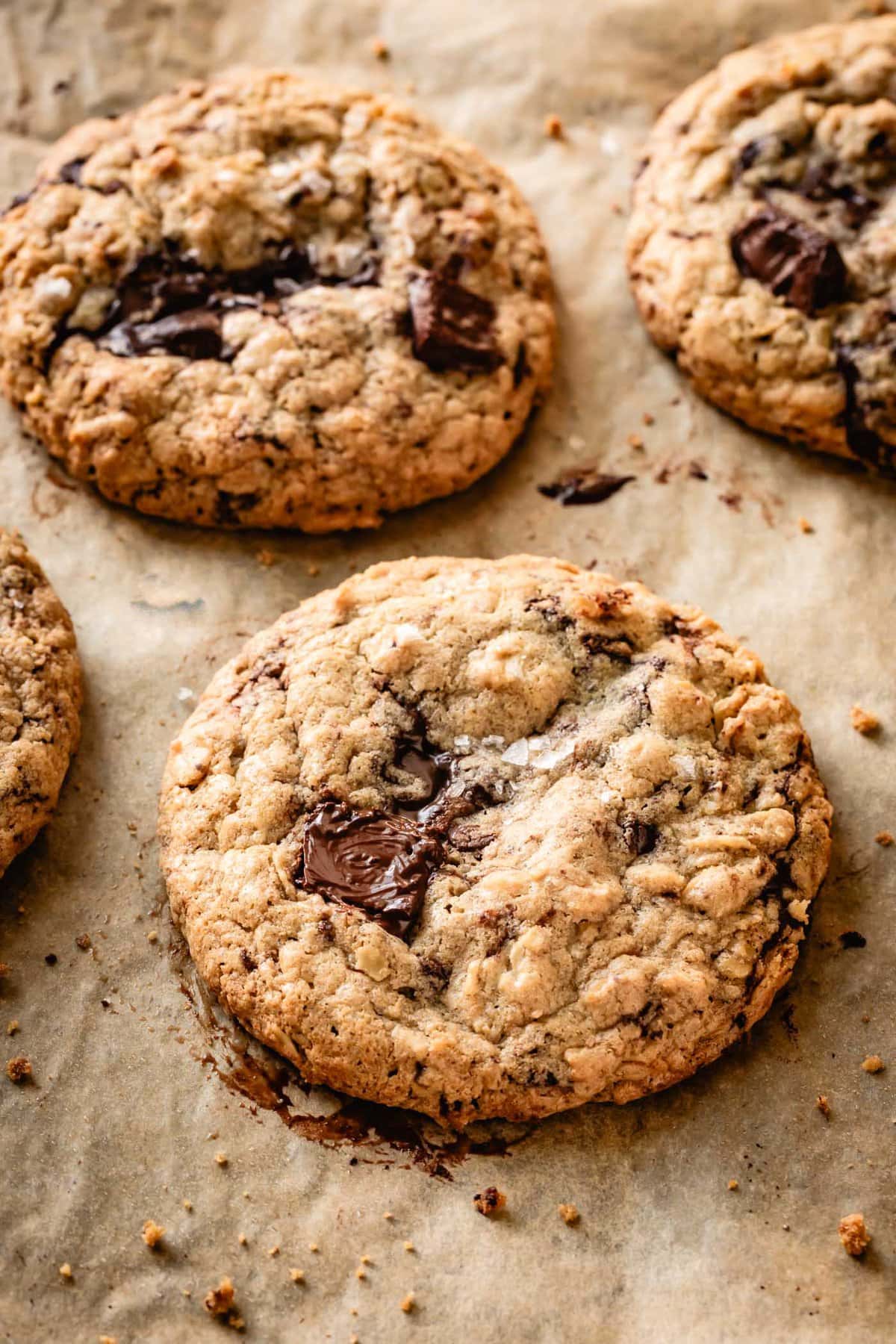
Troubleshooting
Here are some common cookie troubles and how to fix them:
- The cookies spread too much.
- Add 1-2 tablespoons more oat or rice flour to the remaining cookie dough, and/or increase the oven temperature by 25-50 degrees.
- The cookies didn't spread enough.
- Lower the oven temperature by 25-50 degrees and/or flatten the dough balls before baking them. Next time you make them, use a little less flour.
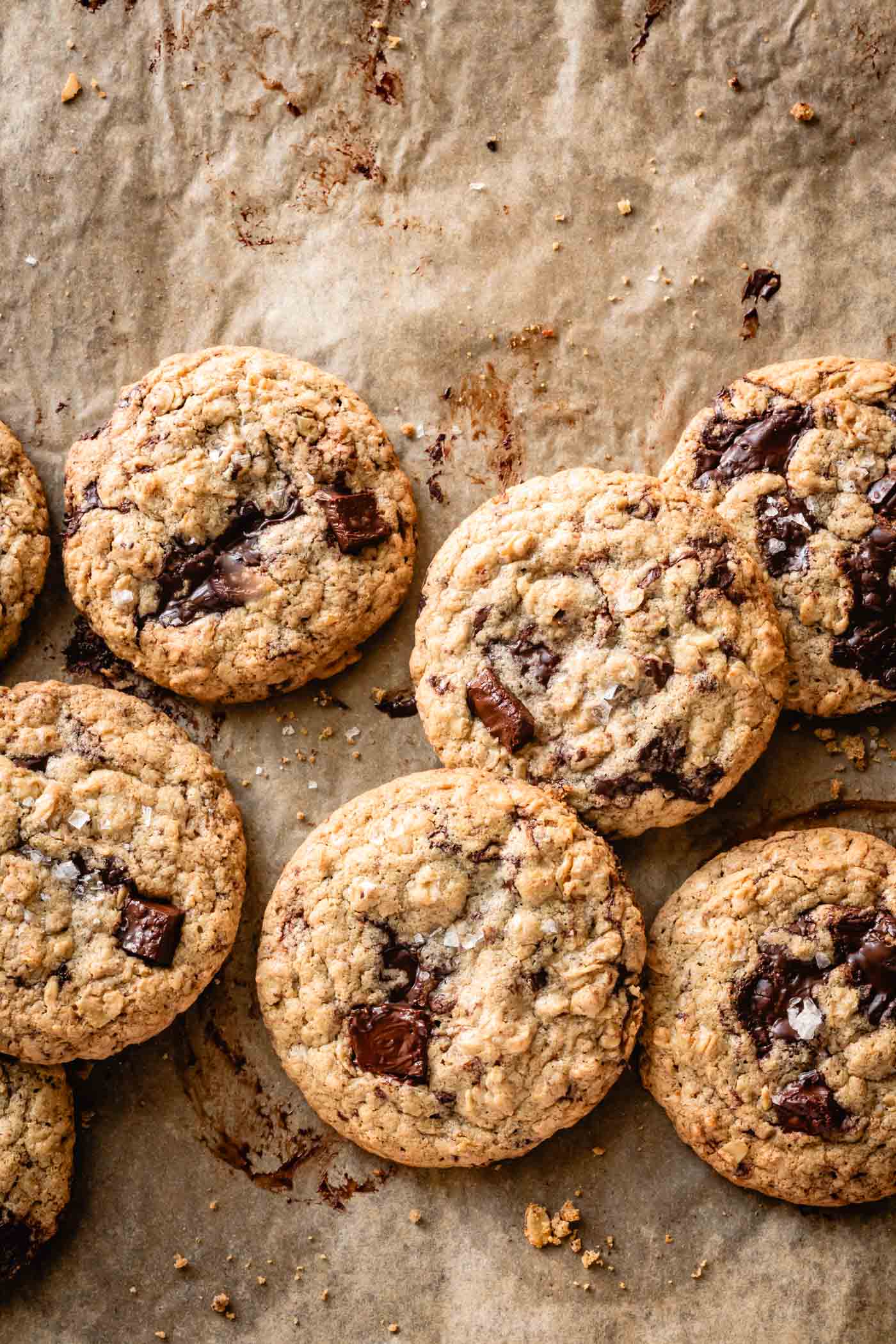
Variations
Here are a few more ways to vary this recipe for more cookie enjoyment.
- Nutty cookies: stir in 3/4 cup toasted pecans or walnuts with the chocolate
- Nibby cookies: stir in 2 tablespoons cacao nibs with the chocolate
- Iced oatmeal cookies: omit the chocolate. Drizzle the baked and cooled cookies with coconut butter icing or maple glaze.
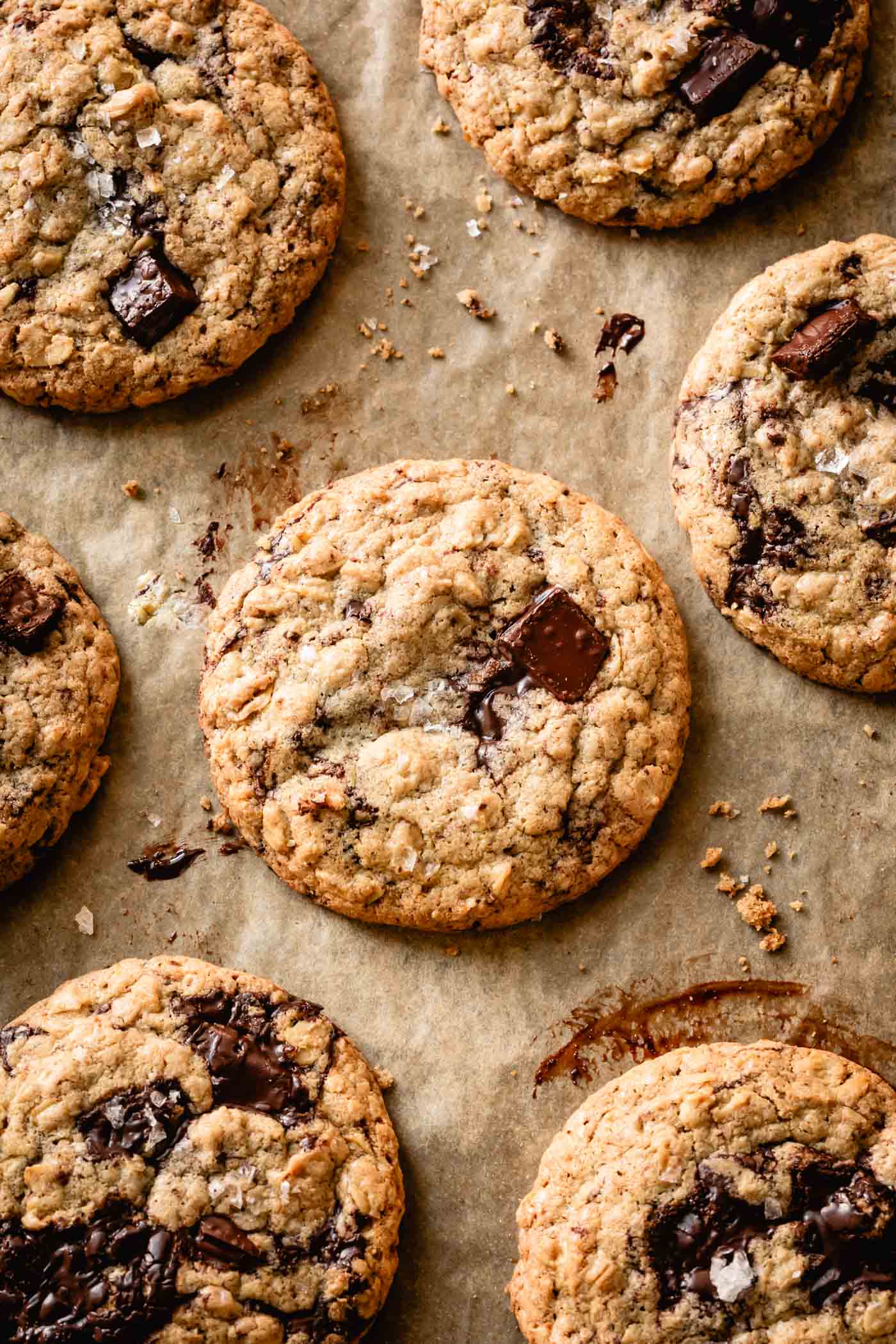
Gluten-Free Oatmeal Cookies for Everyone
And there you have it: exceptionally delicious GF oatmeal cookies made with minimal ingredients. Whether you add chocolate or raisins (or both!), I hope you love these cookies as much as we do.
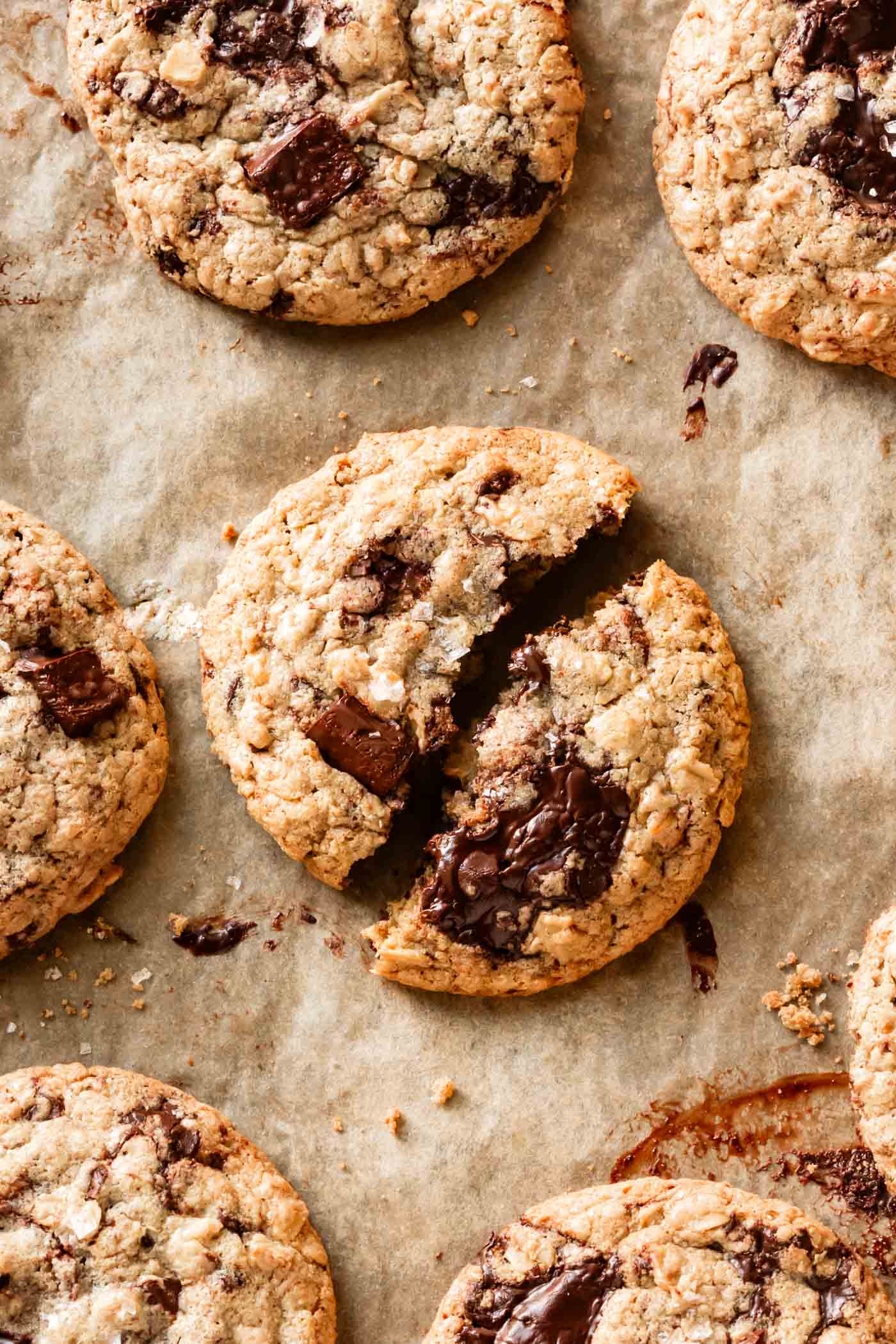
Bojon appétit! For more Bojon Gourmet in your life, follow along on Instagram, Facebook, or Pinterest, purchase my award-winning gluten-free baking cookbook Alternative Baker, or subscribe to receive new posts via email. And if you make this gluten-free oatmeal cookie recipe, I’d love to know. Leave a comment and rating below, and tag your Instagram snaps @The_Bojon_Gourmet and #bojongourmet.
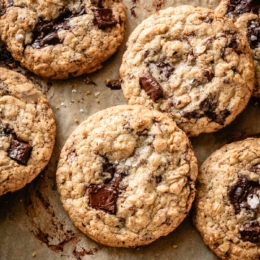
Gluten-Free Oatmeal Cookies (Chocolate or Raisins)
Print Recipe Pin RecipeIngredients
- 1 cup (100 g) gluten-free old-fashioned rolled oats
Wet Ingredients
- 8 tablespoons (113 g) unsalted butter, melted
- ½ cup (100 g) packed light brown sugar*
- ¼ cup (50 g) organic granulated sugar*
- 1 large egg (2 ounces out of the shell)
- 1 teaspoon vanilla extract (omit for raisin cookies)
Dry Ingredients
- ½ cup (78 g) sweet rice flour* (such as Koda Farms Mochiko)
- ½ cup (50 g) gluten-free oat flour* (such as Bob's Red Mill)
- ¼ cup (27 g) tapioca flour*
- ¾ teaspoon fine sea salt
- ½ teaspoon baking soda
For Oatmeal Chocolate Chip Cookies
- 6 ounces (170 g) coarsely chopped bittersweet chocolate or chocolate chips (60-70% cacao mass)
- flaky salt for sprinkling (optional)
For Oatmeal Raisin Cookies
- 1 teaspoon ground cinnamon
- ⅛ teaspoon nutmeg (freshly grated is the best!)
- ½ cup raisins (covered with boiling water or tea for five minutes, then squeezed dry)
Instructions
- Position a rack in the upper third of the oven and preheat to 375ºF. Line two rimless cookie sheets with parchment paper.
- Spread the oats on a small baking sheet lined with parchment paper. Toast the oats until golden and fragrant, about 5 minutes. Remove from the oven and let cool to room temperature.
Make the Cookie Dough
- Place the white and brown sugars in a large bowl. Stir in the melted butter and let cool to warm, about 5 minutes.
- Stir in the egg and vanilla (if using) until smooth.
- Place a mesh strainer over the bowl and sift in the sweet rice, oat, and tapioca flours, baking soda, and salt (and spices, if using).
- Stir the dough vigorously to combine, then stir an additional 60 strokes. This activates the stickiness of the tapioca flour which makes extra sturdy and chewy cookies.
- Stir in the toasted, cooled oats and chocolate or raisins until combined.
- Let the dough sit for a few minutes until thick enough to scoop, or chill briefly.
Bake the Cookies
- Form the dough into balls that are about 2 ½ tablespoons large (a #24 cookie scoop works well).
- Place the dough balls on the prepared cookie sheets, spacing them 2-3 inches apart.
- Top each dough ball with a pinch of flaky salt, if using.
- Bake the cookies until the edges are set and starting to color but the centers are puffed and look underbaked, 8-12 minutes.
- Remove the cookies from the oven and pull them, parchment and all, onto wire racks to cool. They will be delicate at first, but will continue to firm up as they cool.
- Store the cookies at room temperature for up to 5 days.
Notes
- In place of both of the sugars you can substitute coconut sugar by weight
- For sweet rice flour, sub by weight a gluten-free all-purpose flour blend such as Bob's Red Mill 1 to 1.
- For oat flour, sub by weight sorghum, teff, millet, or light buckwheat flour.
- For tapioca flour, sub by weight arrowroot flour or cornstarch.
- Cover the dough and let stand 1-2 hours at room temperature before baking.
- Or scoop the dough into balls and chill airtight until ready to bake, up to 1 week. Or freeze for up to 2 months. Allow the dough balls to soften a bit before baking.
- Nutty cookies: stir in 3/4 cup toasted pecans or walnuts with the chocolate or raisins
- Nibby cookies: stir in 2 tablespoons cacao nibs with the chocolate
- Iced oatmeal cookies: omit the chocolate. Drizzle the baked and cooled cookies with coconut butter icing or maple glaze.
- Note that for the raisin version, the cookies will be on the sweeter side. Feel free to decrease the sugar by 2-4 tablespoons if you like; the cookies will spread less with less sugar.


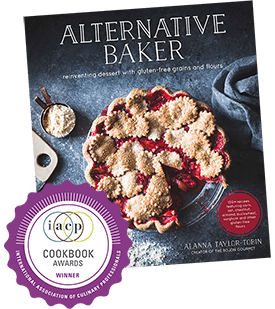

Helene says
You state that to sub both sugars by weight with coconut sugar. What is the gram weight of both sugars so I know what the measurement of the coconut sugar should be? That also goes for the sweet rice flour& oat flour?
Alanna Taylor-Tobin says
Hi Helene,
Yes it's always most accurate to sub by weight. For the sugars, it's 150 grams total. The sweet rice flour is 78 grams, and oat flour is 50 grams. Those are all in the recipe card on my end, I'm not sure why they're not showing up for you. But let me know if I can help any further and if you try the cookies!
-Alanna
Rich says
Can you think of a substitute for GF rolled oats? They're essential for bakes like this one, but unfortunately a family members can't tolerate even GF oats.
I've noticed the "Updated on " notes/dates at the top of some recipes, sometimes for ones I've made prior to the update. It'd be very interesting to know what changed with the updates!
Thanks again for these great bakes!
Alanna Taylor-Tobin says
Hi Rich,
Thanks for the kind words and great questions!
In place of oats, you could try subbing either quinoa flakes or brown rice flakes, or maybe half and half? It may take a bit of adjusting to get the cookies to spread the correct amount since the quinoa and rice flakes may absorb moisture differently and/or cook at a different rate. I would try baking off a tester cookie before chilling the dough; that way, if it spreads a ton you can add more flour to the dough, or if it doesn't spread enough you can add a little liquid to the dough. Please let me know if you experiment!
As for the updates, sometimes it's a very minor update on my end that doesn't affect the recipe at all, such as adding in a link or changing a heading or adding a clarification to the body of the post per a reader comment. For example, if you test this recipe with an oat sub and it works well, I'll add it into the post, which will trigger the "updated" label. ;)
I test my recipes so thoroughly that I don't often change the recipe itself. But if you ever wonder about a specific recipe, feel free to ask!
Happy weekend and happy baking!
-Alanna
Tasha says
Hi Alanna! Thank you for this delicious recipe. The flavor & texture are far superior to any other oatmeal cookie I've ever baked, so kudos :)
My issue is the appearance is not beautifully craggly and thick like the photos - they're wide, flat and mostly smooth on the top. Any suggestions?
Alanna Taylor-Tobin says
Hi Tasha,
Thanks for trying my recipe and for the feedback! Cookies are so sensitive to slight changes in moisture content, the grind of the flour, oven temperature, phases of the moon (kidding about that last one!).. But it's an easy fix!
It sounds like you may just need to add a touch more flour to the cookies so that they bake up thicker. I would try 1 tablespoon each sweet rice and oat flour (about 10 g sweet rice and 7 g oat flour). And baking them in the upper third of the oven helps them brown more on top and can make them more craggly.
You could also try increasing the oven temperature by 25º to see if they brown more. Did you chill the dough before baking? That usually helps them bake up more thick too.
Please let me know if those modifications help!
xo,
A
Angela says
I loved these cookies! Very tasty and not overly sweet! I put in a little almond paste and used slightly less sugar. My company devoured them before they even cooled completely. Thank you!
Alanna Taylor-Tobin says
I'm so glad you liked the cookies and that they were a hit with your company too. Almond paste sounds so delicious here - brilliant!